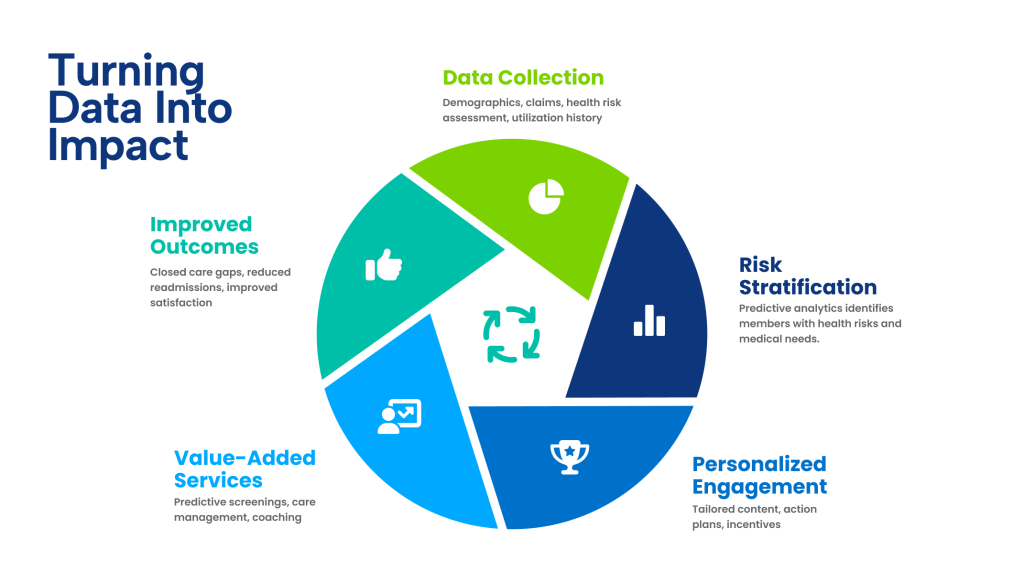Unlocking Better Health Outcomes Through Predictive, Data-Driven Insights

Medicare Advantage (MA) plans are under increasing pressure to improve performance across key metrics such as Star Ratings, HEDIS measures, and risk adjustment accuracy. At the same time, member expectations are evolving, demanding more relevant, timely, and personal experiences. To succeed, plans must move beyond reactive models of care and instead deliver proactive, tailored support that improves outcomes and drives return on investment (ROI). Predictive analytics is the engine that powers this transformation, enabling targeted outreach and personalized member journeys that close gaps and improve outcomes.
The Role of Predictive Analytics in Medicare Advantage
Predictive analytics refers to the use of historical and real-time data to forecast future events or member behaviors. In Medicare Advantage, this means using key data sources—such as demographics, claims, health risk assessments, and care utilization patterns—to anticipate which members are most likely to need intervention. These insights can then drive strategic use cases, including risk stratification, prioritization of outreach, and proactive care planning, allowing health plans to get ahead of rising risk rather than reacting after problems escalate.
Turning Data into Actionable, Personalized Engagement
Predictive analytics only delivers value when it’s applied in meaningful ways. Leading health plans are using it to inform personalized member touchpoints, such as:
- Tailored educational content based on each member’s risk profile, access issues, and social needs
- Condition-specific action plans to support behavior change
- Incentive programs aligned with members’ goals and preferences
These data-driven journeys evolve as member needs change, allowing plans to offer timely support while advancing regulatory goals such as Stars, HEDIS, and CAHPS performance. Personalization rooted in predictive insights makes engagement more effective and sustainable.
Value-Added Services That Drive Outcomes
For predictive analytics to generate a tangible ROI, it must guide members to high-impact, value-added services, particularly those that matter most in the Medicare Advantage context. These include:
- Preventive screenings that identify issues before they escalate
- Care management programs that provide ongoing clinical support
- Chronic condition interventions that help members stabilize and self-manage
By connecting members to these services at the right time, plans improve outcomes and reduce avoidable utilization, such as emergency department visits or hospital readmissions. This is where predictive analytics delivers its greatest value—enabling smarter resource allocation and targeted action.
Evidence of Effectiveness
A recent study by Sharath Akula, Integrating Predictive Analytics in Care Management: A Case Study of Proactive In-Home Interventions for High-Risk Patients (2025), demonstrates the tangible impact of these strategies. In the case study, a healthcare organization used predictive analytics to identify high-risk patients and deployed targeted, in-home interventions. The result: improved patient monitoring, early risk detection, and significantly better chronic disease management. Importantly, this approach reduced hospital readmissions, demonstrating how predictive models can translate into improved health outcomes and cost savings. Read the full study.
Final Takeaways and Strategic Imperatives
The future of Medicare Advantage lies in delivering care that is both personalized and proactive. Predictive analytics provides the foundation for this by helping plans understand member needs, forecast risk, and guide engagement toward high-value actions. As regulatory demands tighten and member expectations rise, digital health platforms with predictive capabilities offer a clear competitive edge.
Plans that act now to embed these insights into the member experience will be best positioned to improve quality scores, reduce costs, and strengthen satisfaction. The message is clear: predictive analytics must become central to the care strategy to connect members with what matters most.
Reference
Sharath Akula. (2025). Integrating Predictive Analytics in Care Management: A Case Study of Proactive in-Home Interventions for High-Risk Patients. International Journal of Research in Computer Applications and Information Technology (IJRCAIT), 8(1), 670-685.


